| 14 May |
• yesterday • tomorrow |
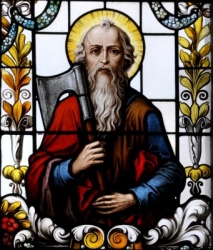
Apostle. As he could bear witness to the Resurrection of Jesus, he was chosen to replace Judas Iscariot. Preached the Gospel for more than 30 years in Judea, Cappadocia, Egypt and Ethiopia. Remembered for preaching the need for mortification of the flesh with regard to all its sensual and irregular desires. Martyr.
• stoned to death at Colchis in 80
• some relics in the abatical church of Trier, Germany, others in Saint Mary Major in Rome, Italy
• against alcoholism; reformed alcoholics
• against smallpox
• carpenters
• tailors
• diocese of Gary, Indiana
• diocese of Great Falls-Billings, Montana
• lance
• spear
"In those days, Peter stood up in the midst of the disciples and said..." As the fiery spirit to whom the flock was entrusted by Christ and as the leader in the band of the apostles, Peter always took the initiative in speaking: "My brothers, we must choose from among our number." He left the decision to the whole body, at once augmenting the honor of those elected and avoiding any suspicion of partiality.
Did not Peter then have the right to make the choice himself? Certainly he had the right, but he did not want to give the appearance of showing special favor to anyone. "And they nominated two," we read, "Joseph, who was called Barsabbas and surnamed Justus, and Matthias." He himself did not nominate them; all present did. But it was he who brought the issue forward, pointing out that it was not his own idea but had been suggested to him by a scriptural prophecy.
And they all prayed together, saying: "You, Lord, know the hearts of men; make your choice known to us. You, not we." Appropriately they said that he knew the hearts of men, because the choice was to be made by him, not by others.
They spoke with such confidence, because someone had to be appointed. They did not say "choose" but "make known to us" the chosen one; "the one you choose," they said, fully aware that everything was being preordained by God. - from a homily on the Acts of the Apostles by Saint John Chrysostom
Almighty God, who into the place of the traitor Judas chose thy faithful servant Matthias to be of the number of the twelve Apostles; grant that Thy Church, being always preserved from false Apostles, may be ordered and guided by faithful and true pastors; through Jesus Christ our Lord. Amen. - collect from the feast of Saint Matthias
https://catholicsaints.info/saint-matthias-the-apostle/
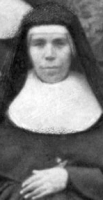
Mary Dominic Mazzarello
Daughter of Giuseppe and Maddalena Mazzarello, the eldest of ten children born to a farm family in the mountains; seven of the children survived, and Maria learned the lessons typical of a big sister. Field worker. Member of the Pious Union of Mary Immaculate. Assisted at her parish, teaching catechism to younger children, helping the sick. She nearly died of typhus at age 23, and she never really recovered her strength or health again.
She and her friend Petronilla began working as dressmakers. They discovered a joint interest in working with children, and started a school for girls that soon turned into a boarding school. Each Sunday they offered the local girls, whether students or not, the chance to come to the school for games and prayers. Maria cofounded the Daughters of Mary Auxiliatrix, which was under the spritual direction of Saint John Bosco. She was the first Salesian Sister, and served as superior of the order, founding houses in Italy and France.
9 May 1837 at Mornese, Acqui, Italy
14 May 1881 in Nizza Monferrato, Asti Italy of natural causes
24 June 1951 by Pope Pius XII
against bodily ills, sickness; sick people
https://catholicsaints.info/saint-maria-mazzarello/
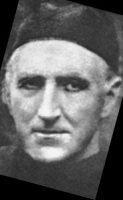
The eldest son of Pyrenean peasants, Arnold and Gratianne Garicoïts. His family sheltered priests escaping the persecutions of the French Revolution. As a boy Michael worked as a shepherd on neighboring farms. He early felt a call to the priesthood, but his family was too poor to afford his eduction; his grandmother arranged for the boy to work in the parish rectory and then in the kitchen of the bishop of Bayonne, France in exchange for his education. Michael studied philosophy at Aire, France, theology in the major seminary at Dax, France and was ordained in the diocese of Bayonne in December 1823. Parish priest in Cambo where he fought Jansenism by promoting frequent communion and devotion to the Sacred Heart. Professor of philosophy at the diocesan seminary at Lestelle-Bétharram, France. Rector of the seminary there. Helped Saint Jeanne Elizabeth des Bichier des Anges to found the Daughters of the Cross (Sisters of Saint Andrew the Apostle). Founded the missioner Priests of the Sacred Heart of Bétharram (Bétharram Fathers) in 1838.
15 April 1797 in Ibarre, Pyrénées-Atlantiques, France
14 May 1863 in Bétharram, Pyrénées-Atlantiques, France of natural causes
6 July 1947 by Pope Pius XII
https://catholicsaints.info/saint-michael-garicoits/
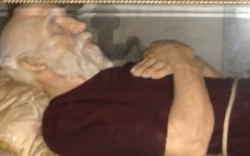
Blacksmith who gave up his work and worldly life to live as a hermit in Thebaid in Egypt. There his chastity was tempted by the devil in the form of a woman, but Ampelio heated an iron bar till it glowed, and used it to chase the demon away; from this choice he received the gift of being impervious to burns. Immigrant to the island of Bordighera, Italy where he planted the first date palms (Bordighera is known as the “Queen of Palms” or “City of Palms”), lived in a cave, was known as a miracle worker, and set an example of prayerful Christian life.
greek: Ampelio = winemaker
4th century in Upper Egypt
• 5 October c.410 in Bordighera, Italy of natural causes
• to punish rebels in Bordighera, civil authorities in Genoa, Italy took the relics to the Olivetan convent of San Stephen in loyal city of Sanremo, Italy in 1140
• relics moved to the convent of Saint Stephen in Genoa, Italy on 14 May 1258
• relics returned to Bordighera on 16 August 1947 and enshrined at the church of Santa Maria Maddalena on Cape Sant’Ampelio
• blacksmiths
• Bordighera, Italy
https://catholicsaints.info/saint-ampelio/
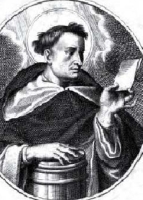
• Giles of Portugal
• Giles of Vauzela
• Egigio, Egidius, Gil
Son of Rodrigo Pelayo Valladaris, governor of Coimbra, Portugal and councillor to King Sancho I. Though his family encouraged him to entered the priesthood, and his royal connections provided him with several benefices and prebends, Gil had no interest. He studied medicine and necromancy; one of his biographers claimed Gil made a blood-sign pact with the devil for knowledge and skills, and that he renounced it only when a spectral knight appeared to him and ordered to change his life. Whether it was a real or metaphorical description, Gil did return to Christianity and studied theology in Paris, France. Joined the Dominicans at Palencia, Spain. Dominican provincial for Spain.
1185 at Vaozela, Portugal
14 May 1265 in Santarem, Portugal of natural causes
9 May 1748 by Pope Benedict XIV (cultus confirmed)
https://catholicsaints.info/blessed-giles-of-santarem/

• Carthage of Lismore
• Carthage of Mochuda
• Mo Chutu mac Fínaill
• Cartaco, Carthach, Carthagus, Mochuda
Swineherd near Castlemaine, Ireland. Monk. Spiritual student of Saint Carthage the Elder. Priest. Hermit at Kiltallagh, Ireland in 580. He attracted would-be students, founded the monastery in Raithean in County Offaly, Ireland c.590, and served as its abbot. Abbot-Bishop of the Fercal district. He composed a rule for his monks. Wrote a metrical poem of 580 lines. Exiled from Raithean in 635 with 800 of his brother monks. With them he established a monastery which later became the famous school of Lismore.
555 in County Kerry, Ireland
• c.637 at Lismore, Ireland
• buried in the church there
• diocese of Lismore, Ireland
• diocese of Waterford and Lismore, Ireland
https://catholicsaints.info/saint-carthage-the-younger/
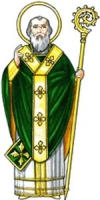
• Costantio
• Constantius
• Antonii de Ripolis
Wandering bishop who preached against heresies in southern Italy, arriving on the island of Capri c.739 where he settled to lead the church there.
in Italy as Antonii de Ripolis
• 8th century near Marina Grande, Capri, Italy
• interred in a barrel
• basilica built in his honour near his burial spot
• some relics enshrined in a reliquary in the church of San Stefano in Capri
• some relics enshrined in a reliquary in the crypt of Saint William at Montevergine, Italy
Capri, Italy (at least since the end of the 10th century when his intervention was asked to fend of invading Saracens)
https://catholicsaints.info/saint-costanzo-of-capri/
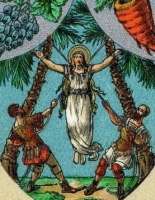
Corona of Damascus
Teenaged wife of an Imperial Roman soldier stationed in Damascus, Syria. Cared for Saint Victor the Martyr when he was arrested for his faith. For this display of her own faith, she was arrested and martyred.
• c.165 in Syria
• an old, probably fictional, account has her tied to two palm trees and torn in half when they were allowed to spring back to their full height
• relics transferred to Aachen, Germany c.1000 by Emperor Otto III
• treasure hunters
• diocese of Belluno-Feltre, Italy
• Castelfidardo, Italy
• Feltre, Italy
• Monte Romano, Italy
https://catholicsaints.info/saint-corona-the-martyr/
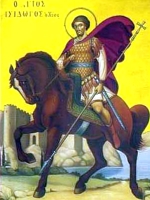
Sailor. Brought Christianity to the Greek island of Chios. Martyred in the persecutions of Decius for refusing to sacrifice to idols.
in Alexandria, Egypt
• drowned in a well c.251 at Chios, Greece
• a church was built over the well, and its waters were considered to have healing powers
• his body was taken to Venice, Italy in 1125 and hidden in the palace of the Doge
• it was re-discovered in the early 14th century and translated to a chapel in Saint Mark's Cathedral
• the skull was discovered on Chios, encased in a silver and jewelled reliquary, and translated to Venice in 1627
sailors
https://catholicsaints.info/saint-isidore-of-chios/
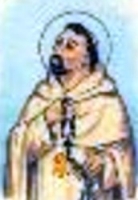
As a young man he felt a call to religious life, and joined the Mercedarians. He attracted so much attention as a miracle worker that for a while he lived a cloistered life at the El Puig monastery at Valencia, Spain. In north Africa he ransomed 108 Christians from Muslim slavery, but was imprisoned, chained and repeatedly flogged for refusing to renounce Christianity. Physically broken, he was released, returned to the El Puig convent, and spent his remaining years as a choir monk.
in Spain of French immigrant parents
interred near the main altar of the church at the convent of El Puig, Valencia, Spain
https://catholicsaints.info/blessed-diego-of-narbonne/
Fortunatus of Vincenza
• 14 August (Aquileia, Italy)
• 13 May (Vincenza, Italy)
Brother of Saint Felice of Aquileia. Martyred in the persecutions of Diocletian.
in Vicenza, Italy
• beheaded in 296 in the San Felice district outside Aquileia, Fruili, Italy
• relics enshrined in Vincenzo, Italy by the late 4th century
• in 1080, due to the Lombard invasions, relics were translated to Malamocco and Chioggia, Italy to be enshrined in the cathedral of Felice and Fortunatus
• Chioggia, Italy
• Vincenza, Italy
https://catholicsaints.info/saint-fortunatus-of-aquileia-14-may/
Felice of Vincenza
• 14 August (Aquileia, Italy)
• 13 May (Vincenza, Italy)
Brother of Saint Fortunatus of Vicenza. Martyred in the persecutions of Diocletian.
in Vicenza, Italy
• beheaded in 296 in the San Felice district outside Aquileia, Italy
• relics enshrined in Vincenzo, Italy by the late 4th century
• relics enshrined on the high altar of the church of Brognoligo, Monteforte d'Alpone, Italy
• Chioggia, Italy
• Vincenza, Italy
https://catholicsaints.info/saint-felice-of-aquileia/
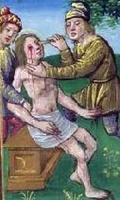
Imperial Roman soldier stationed in Damascus, Syria. Arrested, tortured, blinded and martyred for his faith. While in prison, he was nursed by Saint Corona of Damascus.
beheaded c.165 in Syria
• diocese of Belluno-Feltre, Italy
• Castelfidardo, Italy
• Feltre, Italy
https://catholicsaints.info/saint-victor-the-martyr/
Claudio
Martyr. We have no other information about his life.
• in or near Rome, Italy, date unknown
• buried in the Calepodio catacombs on the Via del Casale di San Pio V in the Aurelio quarter of Rome
• relics exhumed in 1650 and donated to the Jesuits in Antwerp, Belgium
• relics translated to the Jesuit church in Antwerp in 1656
https://catholicsaints.info/saint-claudius-of-antwerp/
• Erembert of Fontenelle
• Erembert of Wocourt
Benedictine monk at Fontenelle Abbey c.640. Bishop of Toulouse, France, c.656, and ruled for 12 years. In his later years he resigned and returned to Fontenelle to spend his remaining years as a monk.
at Wocourt near Passy, France
c.672 at Fontenelle Abbey of natural causes
https://catholicsaints.info/saint-erembert-of-toulouse/
Steward to Saint Alexius. Travelled from Rome, Italy to Tarsus, Cilicia (in modern Turkey) to recover the bodies of martyrs there. Marytred there himself.
• beheaded c.307 in Tarsus, Cilicia (in modern Turkey)
• relics enshrined in the Church of Saints Alexis and Boniface on the Aventine in Rome, Italy
https://catholicsaints.info/saint-boniface-of-tarsus/

Pontius, Ponzio
Traditionally a member of the Theban Legion. Worked with Saint Costanzo to evangelize the region around the rivers Grana and Maira in northern Italy.
Pradleves, Italy
https://catholicsaints.info/saint-pons-of-pradleves/
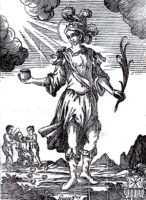
Martyred in the persecutions of Valerian and Gallienus.
• c.258 in Cimella, France
• relics enshrined in Saint-Pons, France, which was named for him
Saint-Pons, France
https://catholicsaints.info/saint-pontius-of-cimiez/
Giusta
Martyred in the persecutions of Hadrian.
c.130 at Sardinia, Italy
• diocese of Ales-Terralba, Italy
• Gesico, Italy
https://catholicsaints.info/saint-justa-of-sardinia/
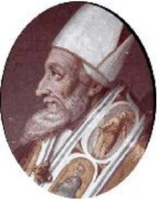
Bishop of Vercelli, Italy c.530. Poet.
c.541 at Vercelli, Italy of natural causes
https://catholicsaints.info/saint-costanzo-of-vercelli/
Enedina
Martyred in the persecutions of Hadrian.
c.130 at Sardinia, Italy
diocese of Ales-Terralba, Italy
https://catholicsaints.info/saint-henedina-of-sardinia/
Sixth century bishop of Ferentino, Tuscany, Italy during the reign of Roman Emperor Justin. Saint Gregory the Great wrote about him.
alcoholics
https://catholicsaints.info/saint-boniface-of-ferentino/
Gallo
Mid-6th-century bishop of Clermont-Ferrand, France. Uncle of Saint Gregory of Tours.
551 of natural causes
https://catholicsaints.info/saint-gal-of-clermont-ferrand/
Franciscan friar and companion of Saint Francis of Assisi in the 12th–13th centuries known for his love of the pious life.
1229 in Assisi, Italy
https://catholicsaints.info/blessed-barbaro-of-assisi/
Giustina
Martyred in the persecutions of Hadrian.
c.130
diocese of Ales-Terralba, Italy
https://catholicsaints.info/saint-justina-of-sardinia/
Totto of Regensburg
Monk and then abbot of Saint Emmeram Abbey in Regensburg, Germany. Bishop of Regensburg.
930
https://catholicsaints.info/saint-tuto-of-regensburg/
Deruvianus, Damian
Second century missionary to the Britons, sent by Pope Saint Eleutherius at the request of King Saint Lucius. Marytr.
https://catholicsaints.info/saint-dyfan/
Son of a poor labourer. Known for his piety, he retreated to live as a hermit near Passau, Germany. Martyr.
1096
https://catholicsaints.info/saint-engelmer/
Martyred in the persecutions of Decius.
stoned to death in Asia Minor (modern Turkey)
https://catholicsaints.info/saint-maximus/
Martyr.
https://catholicsaints.info/saint-augia-of-apt/
A group of lay people martyred together in the apostolic vicariate of Korea.
• Petrus Choe Pil-je
• Lucia Yun Un-hye
• Candida Jeong Bok-hye
• Thaddeus Jeong In-hyeok
• Carolus Jeong Cheol-sang
14 May 1801 at the Small West Gate, Seoul, South Korea
15 August 2014 by Pope Francis
https://catholicsaints.info/martyrs-of-seoul-14-may/
CatholicSaints.Info Portable Edition